 There’s no doubt—manufacturing is a tough industry to work in. With tight turnaround times, increasing shipping demands and the need for immaculate quality, it’s a challenging space for a business to grow and thrive. To further complicate things—administrators are finding it difficult to attract and retain talent.
There’s no doubt—manufacturing is a tough industry to work in. With tight turnaround times, increasing shipping demands and the need for immaculate quality, it’s a challenging space for a business to grow and thrive. To further complicate things—administrators are finding it difficult to attract and retain talent.
According to the Association for Manufacturing Excellence, the average manufacturing and distribution plant has an absenteeism and employee turnover rate of 37 percent. Across the U.S., the average turnover rate is only 3.6 percent. That disparity of 33.4 percent can lead to big problems on the production line. Low retention levels can stress a business of any size through added training costs, a lack of continuity and a degradation of company culture—all of which reduce quality and inhibit productivity.
Striving for a low turnover rate is also critical to long-term success in today’s manufacturing climate. As fewer millennials are interested in working on the floor and the workforce ages—it’s now more important than ever to attract and retain young talent. There are a few simple solutions that facilities can implement to help reduce turnover.
1. Invest up-front. One of the most direct ways to improve retention is to start investing in training programs and courses for employees. When an employee first starts; significant time and resources should be spent during their training and ramp-up phase. It’s often helpful to approach this from several angles—by providing “traditional” training in a classroom setting, along with more informal training through mentorship opportunities on the floor. This will reduce employee stress and ensure they have the tools to succeed. In addition, personal development opportunities should be made available to all employees. Current and perspective employees need to know there is a future to stay engaged and efficient. By investing in your personnel, you are showing them a path forward at your organization and improving the transition once they reach the next step in their career.
2. Rethink your communication channels. You already invest in lean practices on your production floor—why not apply it to your internal communication practices? Station your management on the production floor. This empowers both the employees and management—giving them a direct line of access and allowing both parties to address issues as they arise.
While moving management is a great first step in improving communication, it is still important for employees to be heard and respected by administrators. An open dialogue helps administrators garner important insight by speaking with those on the front lines, and addressing issues as they arise. Administrators and management need to set aside time to give, and receive, employee feedback. This can be done in a variety of ways: company-wide meetings, regular town-hall sessions, and 1:1 meetings between employees and management. Regardless of the method, it’s vital to set aside time from the daily grind to review the current process and determine which types of feedback may be most beneficial to your facility.
3. Take it easy. Many manufacturing jobs are physically demanding—long hours on the floor, excessive motion and movement can all take a toll on employee retention. The physical demands of the floor are one of the major reasons that millennials often choose to work in other industries, even if the pay and hours are comparable to what your facility is offering. Review the current manufacturing process and work to reduce wasted motion and the amount of physical work on the production line. Then, take the steps to readjust the layout to minimize wasted energy. Adding mobile powered workstations can reduce the need for walking to and from a computer, printer or scanner and make the job less physically demanding. Some workstations have height-adjustable features allowing workers to go from standing to sitting. In addition, pay attention to the little things – deploy anti-fatigue floor mats to reduce strain while standing, offer an employee discount for purchasing anti-fatigue shoes, and provide comfortable seating in break rooms and rest areas. These may seem like small adjustments, but added comforts can go a long way in improving employee happiness.
4. Commit to improving work-life integration. Work to ensure employees are invested in all parts of “work-life” at your facility—create a community garden, running club or monthly event that makes employees feel welcome and creates bonds that last. Work with your human resources department to recognize employee birthdays and major life events—even a simple birthday treat can set your facility aside from others in the space. In addition, build opportunities for “work-life” integration: such as a small gym space at your facility, designated spaces and times for necessary personal phone calls, and aid in finding affordable childcare close to the job.
5. Celebrate the small stuff. It may sound simple, but celebrate your victories. Day to day work on the production line can feel disconnected from the overall goals of your organization. Create a new norm by setting aside time for employees to celebrate the company’s successes as a whole, such as “show and tell” time where employees and management can share positive metrics and process improvements that have recently been implemented. Finally, deliberately recognize employee work through incentives such as bonuses, additional time-off or public recognition. A little can go a long way in terms of ensuring that your staff feel valued and appreciated for their hard work and dedication.
Without a doubt, people are the most important resource in a manufacturing facility. Investing in your personnel often generates returns multiple times over and is critical to building an organization that thrives for years to come. Improving retention in your facility will advance productivity and save money in the long run. It’s up to individual owners and managers to solve the industry’s turnover problem and it all starts with helping those on the front lines.
 Kevin Ledversis is the Sales Director at Newcastle Systems, Inc.
Kevin Ledversis is the Sales Director at Newcastle Systems, Inc.
Article originally published in the July 2018 issue of Manufacturing Business Technology.










